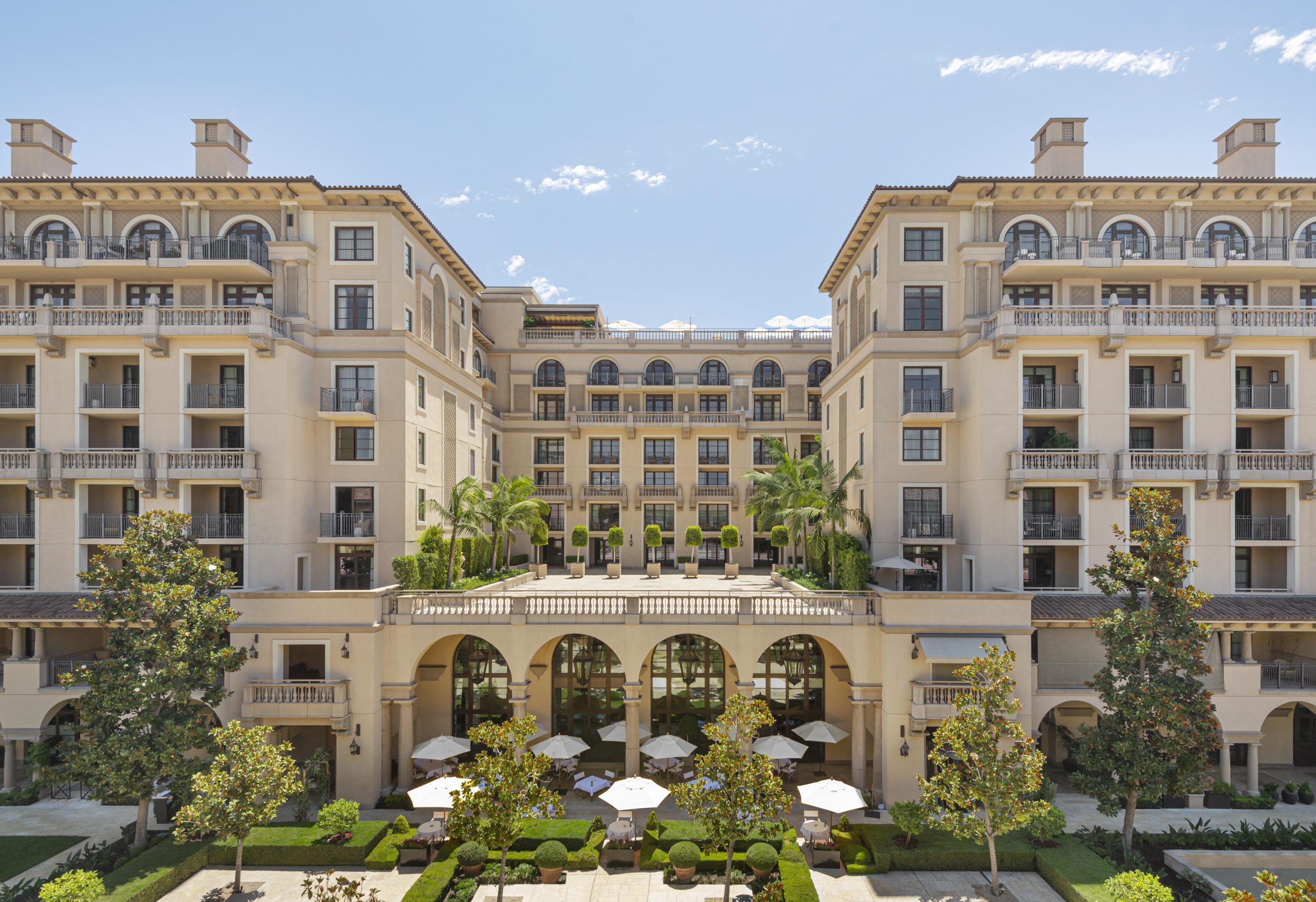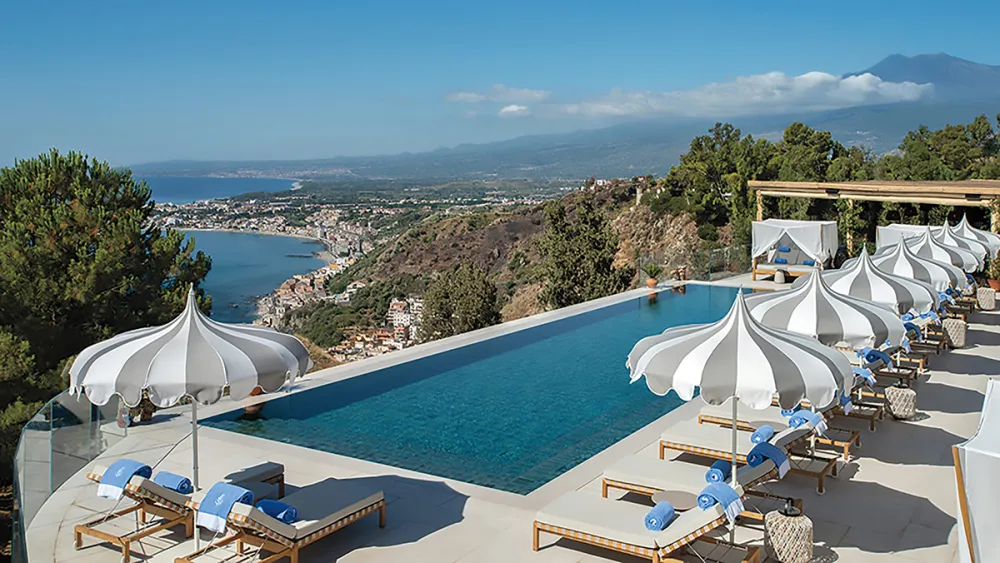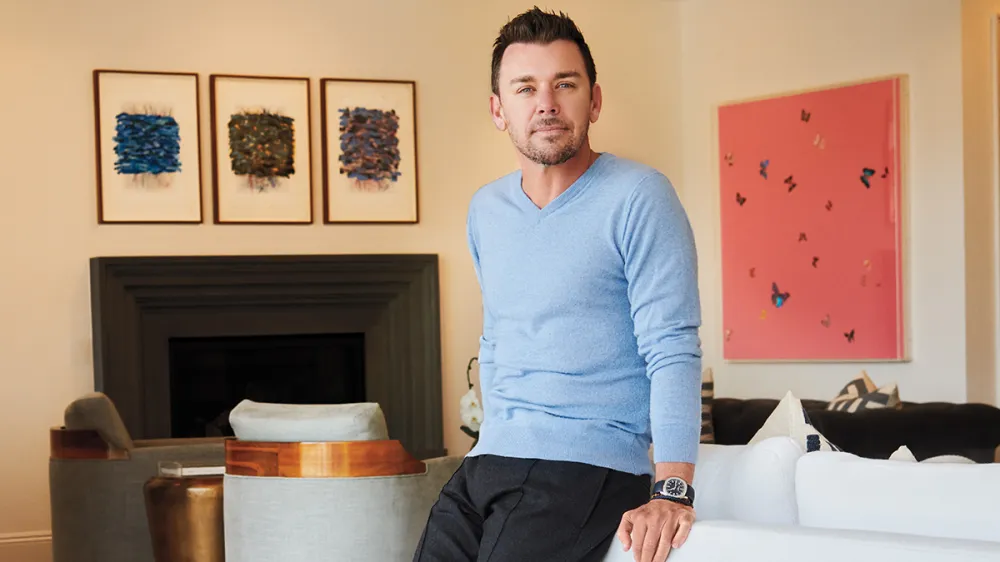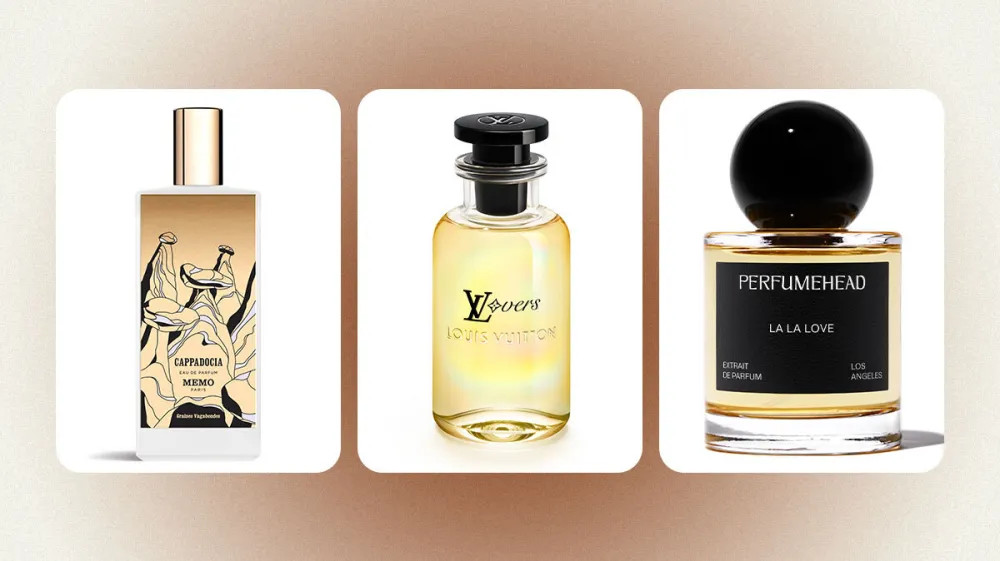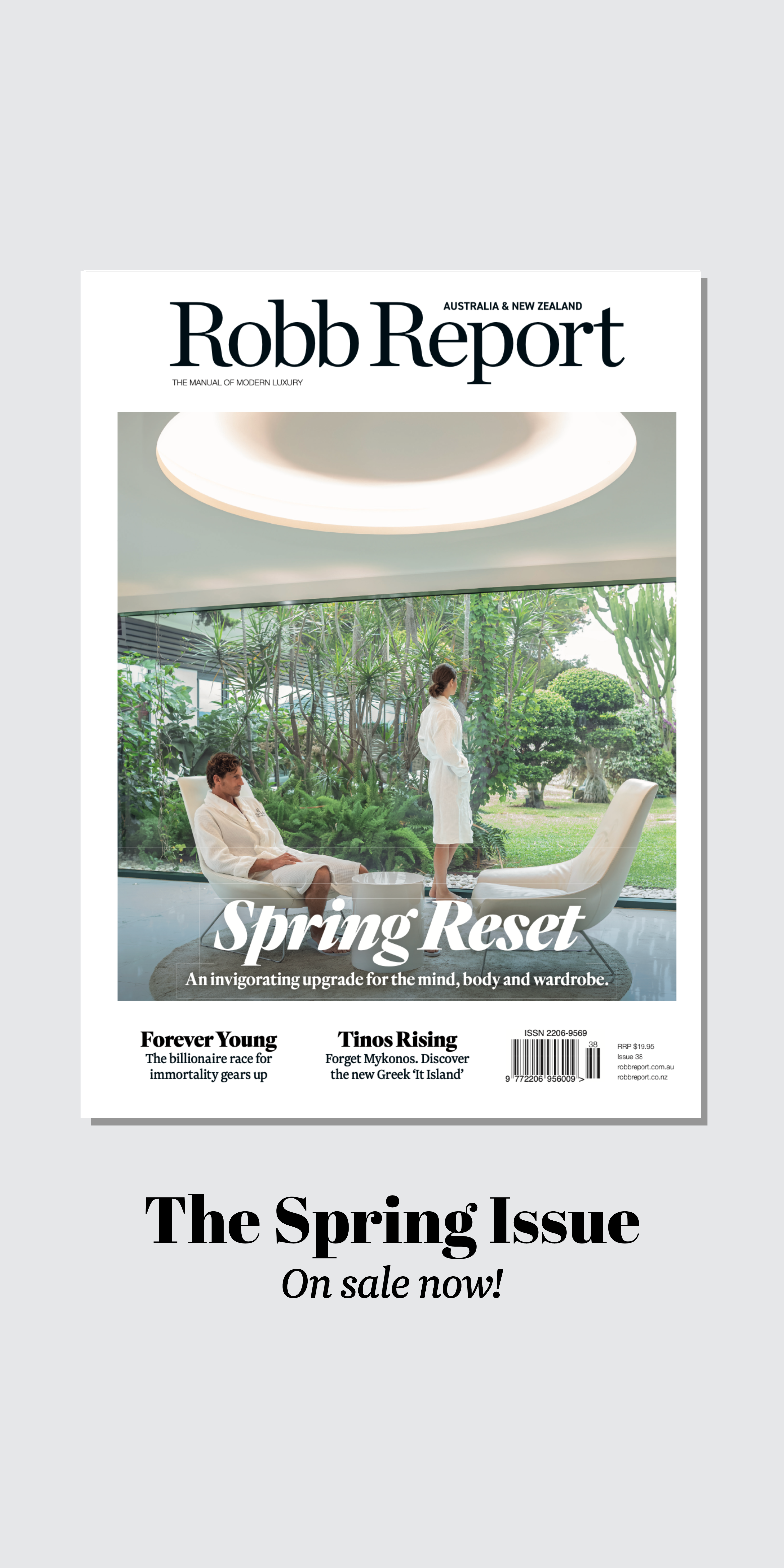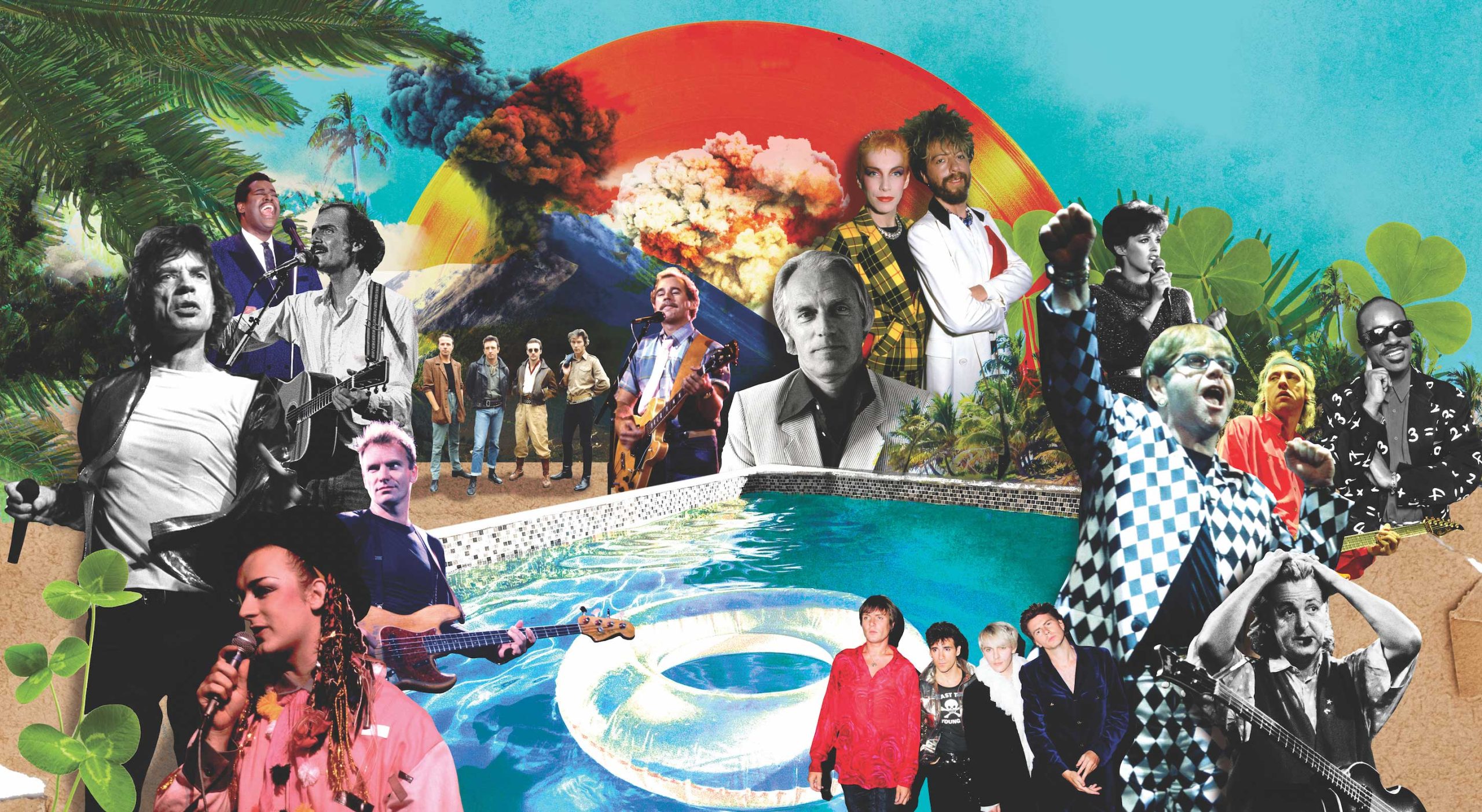
Rock Island
This tiny Caribbean island was beloved by ’80s musicians. Now it’s ready for a comeback.
Related articles
Mick Jagger, Stevie Wonder and Elton John all flocked to idyllic Montserrat to relax and record albums.
The Caribbean island of Montserrat was a jet set getaway in the 1980s after music producer (and so-called “fifth Beatle”) Sir George Martin opened a recording studio there, AIR. The appeal of working with his team—and spending a few weeks or even months recording in a tropical paradise, too—was so compelling that the world’s most famous rockstars flocked there: Mick Jagger, Elton John, Stevie Wonder and Paul McCartney all laid down tracks in Montserrat. The party ended abruptly when twin disasters struck the island, catastrophes from which it’s only just starting to recover. More than 25 years later, though, Montserrat is ready for a comeback.
Ebony and Ivory, Paul McCartney and Stevie Wonder Tug of War (1982)
When one of the Beatles arrived on the Caribbean island of Montserrat in 1981, he was mindful of security. Obviously—he was a Beatle. “Paul McCartney had bodyguards with cutlasses,” recalls local Cecil Wade, who now works as a guide and driver. “But he ended up giving them the money to go off somewhere else and just said, ‘Go ahead, enjoy yourselves.’ ” McCartney himself clearly planned to do much the same, installing his young family in a villa for several months while he worked; old pal Ringo Starr dropped in, making cameos in the home movies McCartney’s entourage shot then. His family, including daughter Stella, barely 10 then, frolic by the pool playing ping-pong, lark around on the balcony that overhangs it, and sit on the top of a cliff amid lush greenery.
The current owner of that villa, Providence Estate House, proudly points to one corner of the living room, which he has painstakingly renovated. Tony Glaser, an expat Briton who used to teach at the local university, notes there was once a piano where the bookcase sits. He indicates a framed colour photograph hanging on a nearby wall: McCartney and Stevie Wonder at that keyboard on the momentous visit when they recorded Ebony and Ivory.
McCartney came to Montserrat at the invitation of George Martin, the aristocratic, low-key producer nicknamed the Fifth Beatle. Martin had chanced upon the island in the late 1970s, when he was casting around for somewhere balmy to build another site for his studios, AIR. “George saw life in segments,” recalls David Lea, an expat American who knew the producer well and has lived here for decades. “First there was Abbey Road and the Beatles. Then AIR. Paul only came because of him.”
Give Me the Reason, Luther Vandross Give Me the Reason (1986)
McCartney wasn’t the only one. Name a chart-topping act, or an album, from the 1980s, and AIR Studios Montserrat will likely be part of the story: Elton John, Duran Duran, the Rolling Stones, Stevie Wonder, Earth Wind & Fire, James Taylor, Jimmy Buffett, Eurythmics, Boy George and Sting all spent extended periods here. Martin, who died in 2016 at the age of 90, opened his state-of-the-art AIR Montserrat in 1979. He also bought a nearby home, Olveston House; it’s now run as a B&B and restaurant. For the studio, Martin converted an old water-storage facility on a hill into a place that the world’s premier rock stars would crave to come. It was named AIR, so the story went, as the recording room was built on ball bearings so it would float even when the supposedly dormant volcano that dominated Montserrat’s skyline would rumble, but, in fact, it’s an acronym for Associated Independent Recording.
There were guest rooms on-site where artists could stay, and a pool, too. Notoriously, many would use the roof as a diving platform, jumping off the top of the building into the deep end. “The real reason their albums turned out so good was that the studio had a pool,” recalls Danny Sweeney, a charmingly roguish surfing instructor who taught many musicians how to catch a wave. “It was a working vacation.”
The good times were not to last, as the rockstar playground of Montserrat was destroyed—not by fire and brimstone, but first by drenching rains, then by molten lava. Now, a quarter century after those twin catastrophes, the Caribbean island is making a comeback. This time, there’s no impresario to lure music’s biggest talents to the mountainous Eden, but the country is leaning into its singular place in rock history—as well as its own indigenous rocks and other natural beauty—to draw paradise seekers.
Walk of Life, Dire Straits Brothers in Arms (1985)
Today, Sweeney is rangy and flirtatious as he sits on the veranda of Olveston House. It’s easy, then, as he recounts a party almost 40 years ago, to picture him strutting around a dance floor for an entire evening, grabbing musicians’ wives and girlfriends to twirl until the early hours. He was always game to dance, but that particular night, he says, he never left the floor and was soaked with sweat when the nightclub closed. A few days later, Sweeney recalls, Mark Knopfler, the lead singer and guitarist of Dire Straits, called him into the studio while he played a snippet of a new song he’d written that Sweeney claims was inspired by his fleet-footing. “I used ‘Johnny’ instead of ‘Danny,’ in case you didn’t like being identified,” Knopfler told him. That tune was Walk of Life.
“I said to him, ‘Your album with this on it? It is going to sell 10 million copies or more,’ but he said the most he’d ever sold was 5 million,” Sweeney says now. “He promised to buy a new windsurfer if I was right.” He pauses, relishing the punchline to a story that he has clearly told many times before. “I am still waiting.” The album, Brothers in Arms, has sold more than 30 million copies worldwide, putting it comfortably in the top 50 best-selling albums of all time. Asked to comment for this story, Knopfler declined.
Turn It Into Something Good, Earth Wind & Fire Faces (1980)
Bassist Verdine White is a founding member of Earth Wind & Fire. He and his late brother, Maurice, the band’s front man, met George Martin during the filming of 1978’s flop movie adaptation of Sgt. Pepper’s Lonely Hearts Club Band. White tells Robb Report that he heard about the producer’s plans for AIR Montserrat then. “He invited us to come and record any time it was convenient for us, and it was perfect timing,” White says. “We chose to record our double LP Faces there, because it was a departure from what we had been doing. We needed to go back to basics, playing good tracks without trying to be commercial.”
White was smitten with Montserrat from the moment he arrived—mostly the friendliness of the locals. “The workers in the field dropped their tools and started applauding as we passed by,” he recalls. “As the only group of colour to record there, we were just honoured and happy.” He emphasises how the relaxed, welcoming vibe of the island was an ideal creative proving ground and how much the people there embraced the visiting musicians. “We didn’t get a chance to jam with the people, but the chef who prepared our meals was also a famous local DJ. He played our records during his time on the air and gave us tremendous shoutouts almost every day. We always listened to his show during mealtimes.”
I’m Still Standing, Elton John Too Low For Zero (1983)
James “Scriber” Daley, a local park ranger, has particularly fond memories of Elton John, who visited the island multiple times. “Lemme tell you, he would come hang out, and one Sunday, news got around he was in the village,” Daley recalls, noting that all the locals came down to say hello. Touched by the warm greeting, John told the bartender to put the entire afternoon’s tab on his check. (For John, Montserrat proved truly life-changing: he married AIR sound engineer Renate Blauel in 1984. They divorced four years later.)
Midge Ure of Ultravox fame loved Montserrat so much he bought a home here, though he’s reportedly called that purchase “the stupidest thing I did in the 1980s, because it was infested with termites.” Sting became smitten with the island, recording solo albums here after the Police split and renting a house for vacations with his wife and kids.
Not every rock star relished their time on Montserrat, though. One resident claims that Mick Jagger never seemed happy in Montserrat. “He hated it here, because nobody paid attention to him, so he’d walk back and forth to try and get noticed,” she says. But another disagrees, frowning. “Oh no, it wasn’t Mick. It was Duran Duran—they missed all the screaming girls.”
Looking at what remains of AIR now, though, one finds it hard to imagine those antics. There’s chain-link fencing across the driveway, featuring a KEEP OUT sign, erected by the Martin family. “We regret the need to restrict access… ” it says, almost apologetically. The site’s a ruin, festooned with wasps’ nests, its windows glassless and what remains of the roofs askew. It was pummelled not once, but twice, by those disasters that struck the country three decades ago.
Calm Before the Storm, Sheena Easton Take My Time (1981)
Hurricane Hugo punched first. The 1989 storm passed right over the country, the first such direct hit in decades. The devastation was widespread. One local estimates that 95 percent of the houses here were left without a roof. As for AIR, that bunker-like building was built to survive. The thick concrete walls, essential for a soundproof studio, withstood the winds well. The problem was power: the on-site backup generator, a fail-safe during the island’s regular brownouts to ensure that no rock star’s riff ever went to waste, was broken. “Poor maintenance,” says one local, grumbling about the lapse.
In the wake of the power loss caused by the storm, both heat and moisture wreaked havoc at AIR. When Martin arrived to inspect the damage a few weeks later, Danny Sweeney recounts, the impresario opened the piano to look at the keys. The ivories were already covered in green mould. There was no money to restore the studio—or rather, no point. As the 1980s ended, record-company budgets were shrinking. With improved technology, corporate studios became obsolete, and the penny-pinchers saw little reason to underwrite a three-month stint in the sun for Paul McCartney, Dire Straits or anyone else. “I asked him if Hugo hadn’t hit, whether it would still be open,” says David Lea. “And George told me, ‘Oh no, never. Digital was taking over.’ ”
Rock and a Hard Place, Rolling Stones Steel Wheels (1989)
Perhaps, though, Martin might have found a way to reboot his enterprise—AIR still operates a site in the UK, after all—had a second disaster not struck just six years later. The locals had long learned in school that the volcano here, Soufrière Hills, which dominated the southwest centre of the pear-shaped country, was a dormant relic despite the occasional burping rumble. In 1995, those lessons were proved wrong. Rumblings continued for two years, until a major eruption in summer 1997. Nineteen people were killed, and two-thirds or so of Montserrat’s land—including all of its most fertile farmland, as well as the thriving capital, Plymouth—became uninhabitable, buried beneath ash and lava like a Caribbean Pompeii.
It’s possible now to visit what remains of Plymouth, albeit with a guide, and wander around the rubble-strewn roads. Three-storey buildings sit, poking slightly out of the ground, their interiors full of once-molten lava. Entering the exclusion zone here—a no man’s land, a tropical DMZ—one notices the roads instantly become rougher, and the air starts to stink with sulfur. “When the eruption happened, it was so strong you had to hold your nose. It burned,” says guide Cecil Wade, standing in the centre of the former downtown. Now the only activity is the dusty thunder of trucks, which crisscross the land carrying sand mined from the volcanic ash—so much better for construction, as it’s salt-free, unlike a beachy supply. It’s commodity as apology, as if the volcano is trying to give back something after wrecking the locals’ lives.
The volcano is still considered active, and its seismic movement is closely tracked via an observation post manned by staff from the University of the West Indies. It’s deemed safe enough, however, for the authorities to open some sections on the northern edge of the exclusion zone to visitors to explore unaccompanied, including the area around AIR Studios, for example, or the once-upmarket district of Richmond Hill. Most of the homes there are half-hidden in the undergrowth, after 25 years of nature reclaiming the landscape. Occasionally, though, one shows through, gleamingly pristine—take the squat blue box, its window sills painted egg-yolk yellow nestled amid the ruins. “They can’t go back,” says Scriber Daley of the owners of these sentimental but futile renovations, which still lack electricity and running water. “But psychologically, in their minds? They have it that they might one day. Sometimes people now go and lie down there, sleep and rest themselves for a while. Just to reminisce about the past.”
Living in the Past, Midge Ure The Gift (1985)
It was a ruinous disaster for a place with such a storied history. In the aftermath, Montserrat’s population was offered free passage, and passports, to live in the UK. Three-quarters of locals took one-way flights out. A hardy contingent remained, though. “I wasn’t tempted to leave,” recalls David Lea. “When the last ferry leaves, I’ll be on the one after that.” Instead, he salvaged what he could—one dial from the old Plymouth clocktower, for instance—and created a shrine to that era in memorabilia, ranged among the tables of his bar, the Hilltop Coffee House.
Modern Montserratians may now have British passports, but the first Europeans here were Irish, mostly indentured workers banished to the otherwise uninhabited island from the plantations on nearby St. Kitts after one too many rebellions. Their culture is palpable even now: in places with names such as Cork Hill or Galway, the shamrock on the welcome stamp in every passport and even the national dish—squint a little at a bowl of goat water and it could be Irish stew. St. Patrick’s Day is a national holiday on Montserrat, the only country other than Ireland proper. “We’re Afro-Irish,” adds Kenneth Silcott, a former champion calypso king who now runs the arts council. “At the St. Patrick’s feast, you’ll see some people in full green garb and others in African dress.”
Hot Hot Hot, Arrow Hot Hot Hot (1983)
Those Irish immigrants also brought music, which was a cherished part of the Montserratian life well before Martin and co. arrived. Their love for it commingled with the African traditions of the enslaved people who were shipped to the island to work on the sugar plantations. “Music for us is an integral part of our culture,” says Rose Willock, a longtime host at local radio station ZJB. Music here, she explains, combines Celtic and African traditions—the Oriole String Band, for instance, today plays a repertoire that ranges from soca to chanteys. Look closely at the carnival dancing, too, and you might recognise Irish toe-stepping in its movements.
Montserrat’s most famous homegrown musician, though, was Alphonsus Cassell, better known as Arrow. He and his brother wrote the worldwide smash “Hot Hot Hot” on the island, and Arrow carved out a path for a distinctive soca sound that incorporated merengue beats into its rhythmic fusion. Cody Greenwood was a regular visitor to Montserrat as a child and just 5 years old when the eruption happened; she produced the recent documentary Under the Volcano, about the AIR Studios era. “It was important for me to acknowledge local music in it—the soca, too. It’s been embedded in the culture forever, and Arrow is really the local hero down here, even now,” she says of the musician, who died in 2010. “The strong music culture meant when artists would come down, the locals would sing on a lot of the albums, like for Elton John or Dire Straits.”
Boat Drinks, Jimmy Buffett Volcano (1979)
Greenwood hoped that her film would pique viewers’ curiosity about Montserrat and tempt them to visit—she’d even intended to premiere it on the island with the goal of luring some of those rock-star icons to return for a nostalgic look. Pandemic lockdowns precluded any such celebrations. The local government does have concrete plans, though, to draw tourists. They’re centred on Little Bay, close to the northern tip of the island and near the country’s new commercial and political hub.
Little Bay became the emergency base for supplies after the eruption, but the waters here are too shallow for much commercial shipping or any superyacht. Dredging to rectify that problem has begun, and there’s a big patch of dusty scrubland on the waterfront ready for construction of a port that can harbour high-end cruise ships and private vessels by bolstering the jetty to 130 metres and the depth of waters from 3 to 8 metres. “Little Bay is one of the most sheltered harbours on the island,” explains Dion Weekes, the project manager. “And we want to have yachts calling there in 18 months.”
Spirits in the Material World, The Police Ghost in the Machine (1981)
Doubtless, many will come to make pilgrimages to AIR and Olveston House, a chance to connect with an overgrown corner of rock history. But there’s more to Montserrat than rubble. Much like neighboring Dominica’s, the countryside here is lush and quilted with trails.
Scriber Daley—he earned his nickname at school, because he was such a good describer—is the ideal guide for exploring. Walking under the forest canopy with him is like accompanying Dr. Doolittle. He holds a thumb to his lips, sucking and tutting simultaneously like a scolding kiss. In response, the tree up ahead starts filling with Montserrat orioles, the national bird found only on the island; they twitter noisily in reply, more and more gathering to answer his calls.
Daley relishes the chance to take folks hiking for hours over Hope Ridge or Katy Hill, looking for birds or the Montserrat orchid. But one animal no one ever sees or hears now is a cricket he calls the spoon-in-glass. “It would go ting-ting-ting, and it was a sign to drop everything and leave the forest, because night could come over very fast,” he recalls. After decades of its silence, though, Daley fears this insect was wiped out in the wake of the eruption. “I have slept over there in the forest to see if I could hear the sound. It was so lovely. I never have.” He remains hopeful, though, and he doesn’t stop trying.
Despite the natural disasters’ upheaval, little about the island’s culture has changed. “My mum always used to say to me, ‘You don’t lock up here—no one will rob you,’” says Greenwood. “We had over a million dollars’ worth of camera equipment, and we could never find a key for our villa, but people just said, ‘You don’t have to worry.’ On Montserrat, you don’t have to worry about a thing.”
Subscribe to the Newsletter
Recommended for you
Golden Touch
Discretion is the better part of glamour at the glittering Maybourne Beverly Hills.
October 9, 2024
White Lotus-ing? How Hit Films and TV Shows Are Inspiring Elite Travelers to ‘Set-Jet’ Across the Globe
It’s not just The White Lotus. Prestige TV and blockbuster films set in far-flung destinations are driving bookings like never before.
October 2, 2024
You may also like.
18/10/2024
You may also like.
Top Gear
Segue from supercar to sand—and beyond—with Lamborghini and Orlebar Brown’s high-performance hook-up.
Fasten your seatbelts, Automobili Lamborghini and Orlebar Brown are racing to the shore with a new swim, beach and resort collection. The dashing new capsule range comprises swim shorts, polos, resort shirts and trousers, polos, and t-shirts to take you from supercar to sand, then onto the bar or restaurant.
Each piece is a nod to the exotic colours and inspired details that the marque’s owners and fans will appreciate, including the legendary hex of Lambo exhausts and vents. Even better, the collaboration will run for three years. Which sounds like an awesome fashion road trip to us.
See more at orlebarbrown.com; lamborghinistore.com
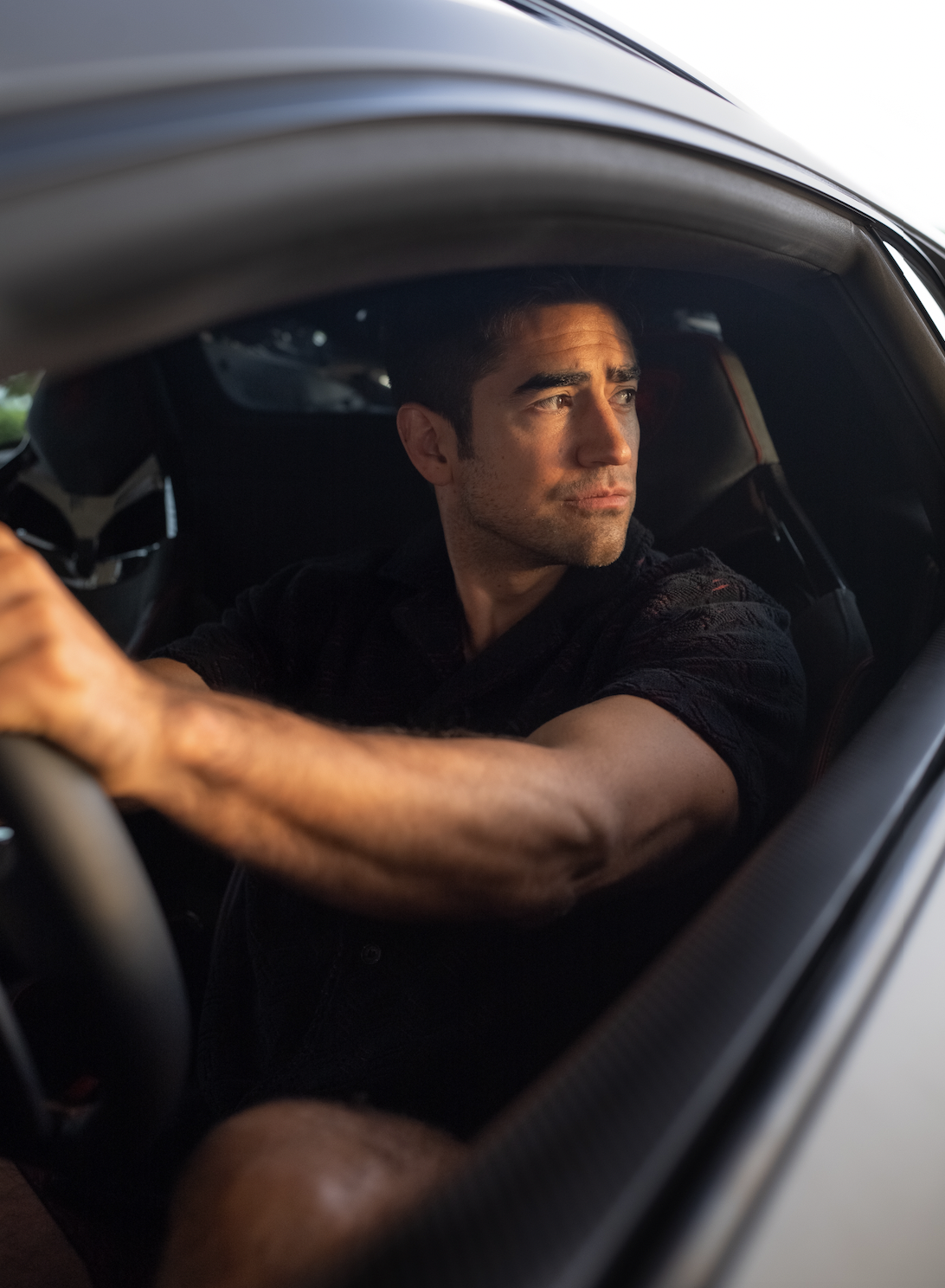
You may also like.
Entrepreneur Blake Johnson on Buying a Soccer Team, His 1969 Bronco and His Favourite Watch
The self-made businessman went from working on a ranch to launching businesses worth over $2 billion.
Johnson’s rise, from waking at 3.00 am to work cattle on his family’s California ranch to becoming a self-made billionaire, began at school—but not necessarily in the classroom. “I remember running round corners trying not to get caught selling lollipops,” he says. At 47, Johnson has created and sold businesses for a combined total of around $2.3 billion. His direct-to-consumer orthodontics provider, Byte, reached a billion US dollars ($1.5 billion) in valuation without any external investment; Alter, a fitness brand focusing on DNA and daily biometrics, “is on a trajectory to exceed that number by multiples”, he says. His seventh enterprise—a consumer-finance company, Forma—has just launched.
Success has allowed Johnson to explore passions including art, watches, pens and philanthropy. “I’ve had so many lucky breaks along the way—especially at the age when the concrete is still wet, so to speak—and I’ve always felt compelled to give back,” he says. Beneficiaries include International Justice Mission, Heart of Los Angeles (HOLA), and various arts, science and educational establishments.
Johnson is perpetually on the move but finds himself returning to a long-term aim: “I’ve become obsessed with starting a school for kids from 12 to 20 years old. I believe I can fix core problems existing in our education system.”
What have you done recently for the first time?
Became an owner of a sports team. I invested in a UK soccer club called Hampton & Richmond Borough FC. I went out there to go to a game in January, but the pitch was frozen.
First thing you do in the morning?
I like to knock out the items I’m least looking forward to: from workouts to analysing financials to difficult decisions and hard conversations.
Do you have any personal rituals?
I love to travel by myself. I appreciate travelling with my family and friends, but being on the road solo is liberating. I’m perpetually curious and yearn to see what’s over that next hill and meet the next person.
What do you do that’s still analog?
I have a collection of fountain pens, each filled with a specific brown ink, and I keep cream-coloured stationery and cards to write letters on. I write in cursive script and take great care with each presentation. It’s becoming a lost art, but one that I’ll never let go of.
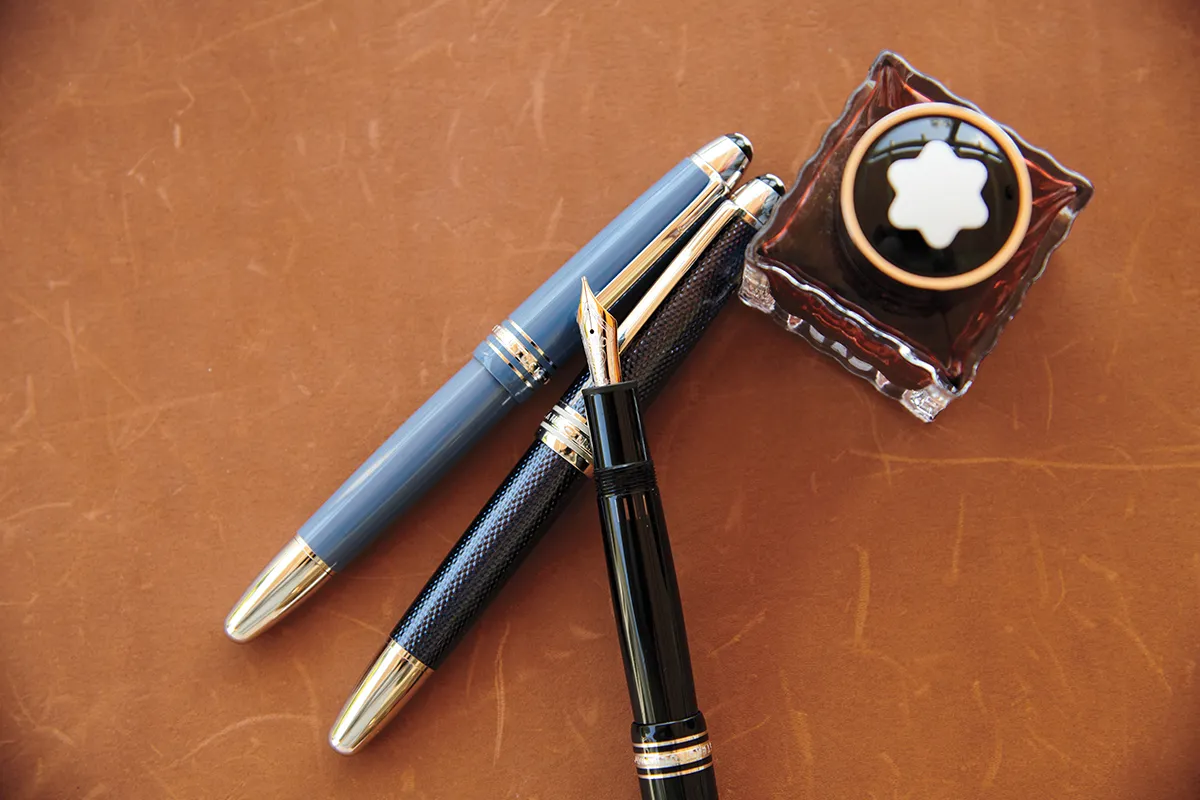
Jeff Lipsky
What in your wardrobe do you wear most often?
I’m not shy to rock a scarf any chance I can. I’m a sucker for Loro Piana. I’m headed to Africa tonight, and the family member I’m travelling with joked that I needed to pack an extra suitcase for all my scarves.
Drive or be driven?
Nothing makes me happier than being behind the wheel, but I’m now driven the majority of the time. I own a few cars, including a 1969 Icon Bronco. It’s a real head-turner. You’re driving along and people are honking and giving you thumbs-up. The car I’m driven in mostly is a [Cadillac] Escalade.

Jeff Lipsky
What’s your favourite cocktail, and how do you make it?
Year-round in Southern California: tequila with a splash of soda water and a slice of orange. Summers in Lake Como: negronis. Winters in England: elevenses with the boys. Mexico: cerveza with tobala mezcal neat.
Who is your dealer, and what do they source for you?
CJ, hailing from London and Monaco, is well on his way to becoming the biggest contemporary-art dealer on the planet, and I find myself heavily following his lead on blue-chip artists.
What’s the most recent thing you’ve added to your collection?
A piece by George Condo, Mr. & Mrs. Strange. You see some great artists—from Richard Prince to Damien Hirst—shift their style. This one blended an old style with a new style on the same canvas.
What’s the most recent thing you regret not buying?
More real estate in 2021, when it was better to be lucky than to be good. I had my eye on a ranch in Colorado that I passed on, and I still mourn it weekly. It’s funny, they say you spend your early adult life running away from your childhood and your later adult life running back to it.
How do you get to sleep?
I fall asleep within 30 seconds of my head hitting the pillow. I’m an early-to-bed, super-early-to-rise guy. It comes from having to get up at 3.05 am daily to work cattle in my youth.
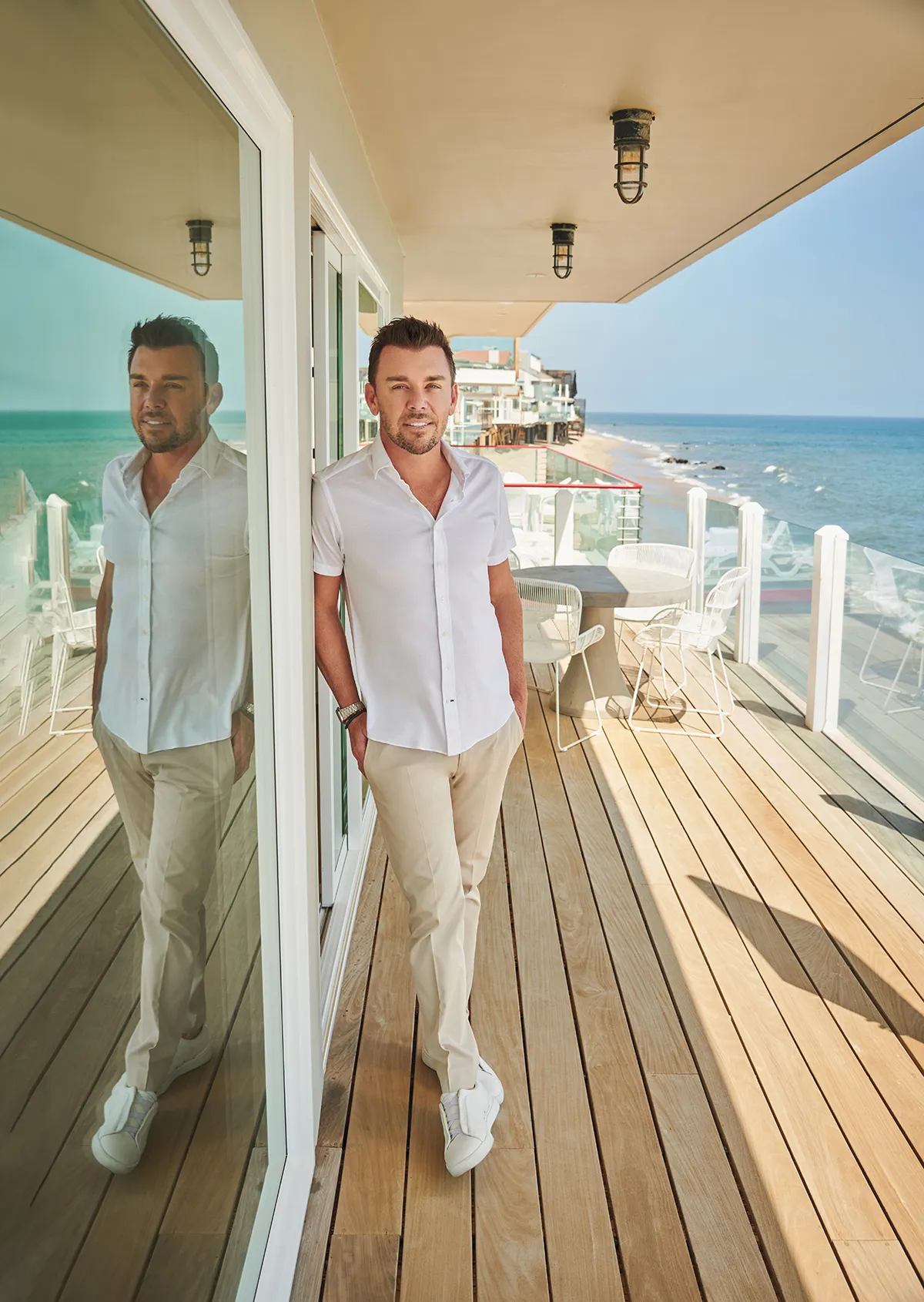
What does success look like to you?
My views of success constantly change. Having my children balanced with broad perspectives and fundamentally strong characters is top of the list.
Who is your guru?
I’ve always prided myself on not having one and carving my own way through life. However, I’ve recently had the good fortune to spend days with Guy Ritchie at Ashcombe, his estate in England. Brief moments of conversation with him have forever changed my views on life and humanity. His EQ [emotional quotient, more commonly known as emotional intelligence] is off the charts.
Are you wearing a watch?
Yes, a Patek Nautilus 5976—my favourite piece out of around 25 I own.
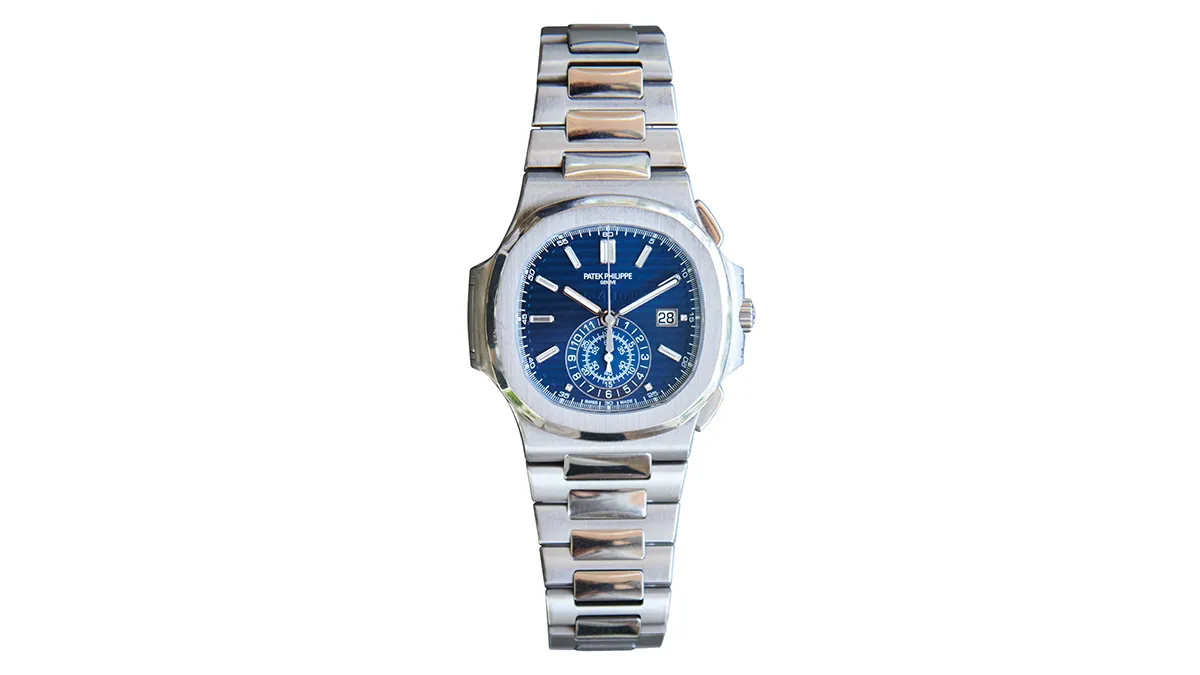
Jeff Lipsky
How would you describe your look?
Multifaceted. I love British sophistication, Italian understated elegance, American Western wear. But most importantly, I love a good tailor. Regardless of style, if it’s not fitted, it’s not right.
What’s your favourite hotel?
It’s a tie between the Mandarin Oriental in Lake Como, the Brando in French Polynesia and Claridge’s in London.
Who do you admire most in the world?
I admire those who live [in] the arena, whose faces are weathered by hard work, valiant efforts and material results. I admire anyone with grit, the nimbleness to think on their feet and a strong positive attitude.
Last piece of advice you gave?
There are three essentials in life: something to do, something to love and something to hope for. If you’re missing one, life will be out of balance.
And the last advice you were given?
Grasp the difference between jungle and zoo lions. Independence is earned, dependence is free. No one ever did anything impressive in the zoo.
What kind of music makes you happy?
From George Strait and Chris Stapleton to Maná or Luis Miguel to George Michael and ’80s pop to Motown and [Norwegian DJ] Kygo and other EDM.
You may also like.
Follow Your Nose
Embark on an olfactory adventure with these location-inspired scents.
At the end of a memorable visit to the Dominican Republic, Robert Gerstner decided to commission a souvenir. He’d been fascinated by the aromas of cigars being rolled and boxed during a factory tour, so he asked his friend and travelling companion, the perfumer Bertrand Duchaufour, if he could bottle the scent.
“I didn’t really think there were any great tobacco fragrances out there,” Gerstner says, and he would know. For nearly 30 years he’s run Aedes, a New York City perfume shop that offers exclusive scents, including an in-house collection called Aedes de Venustas. The newest, Café Tabac, debuted last December and is the product of Duchaufour’s efforts. It’s named for the Big Apple’s long-shuttered supermodel hangout, but the scent is redolent of the Dominican Republic’s key export.
Since then, a raft of houses have launched scents that are either directly evocative of, or otherwise inspired by, specific destinations—a trend that makes sense given our near-insatiable thirst for visiting new places. “Locations are one of the main things fragrances stir up in you,” Gerstner says.
“It just happens that you get inspired by travelling.”
Arquiste A Grove by the Sea
Lopud, Croatia
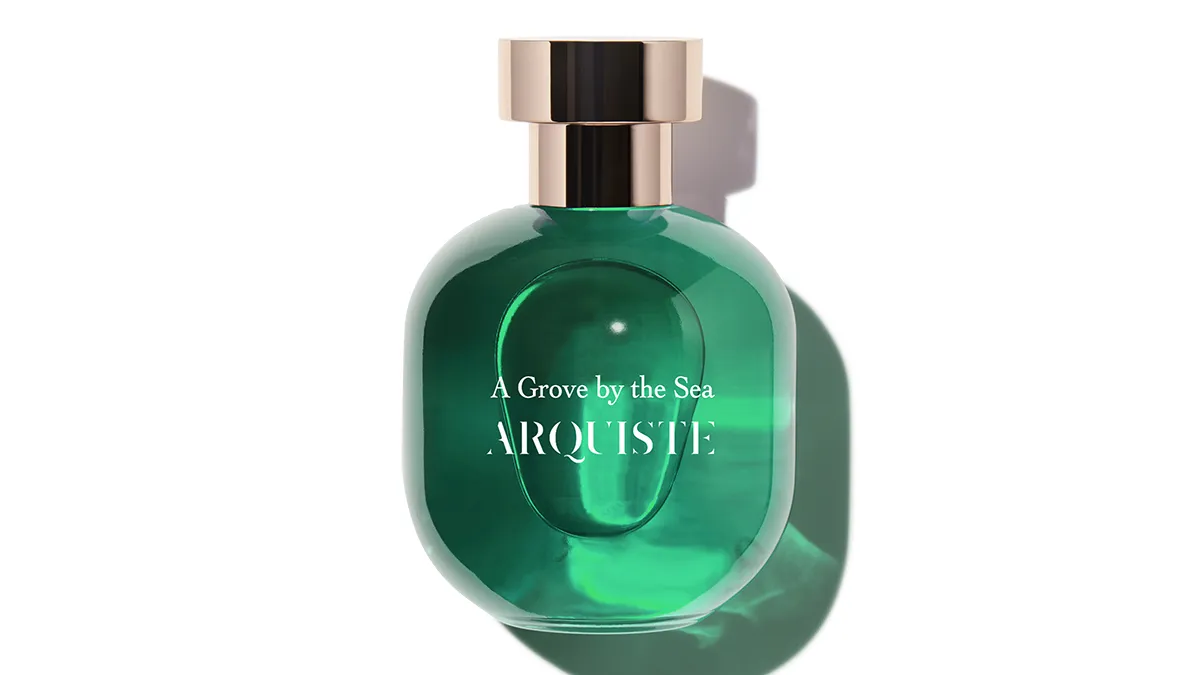
This small island in the Adriatic Sea has forests of pine, cypress and some of the tallest palms in Europe. The scent, created with perfumer Rodrigo Flores-Roux, captures the sea air that blows through their leaves and fronds to combine with the crisp aroma of locally grown thyme, rosemary and figs. Around $330 for 100 ml
Louis Vuitton Lovers
Virginia, USA

Pharrell Williams asked Vuitton’s in-house master perfumer Jacques Cavallier-Belletrud to capture the energy of sunshine. The result—named in reference to Williams’s home state, Virginia (which, they say, is for lovers)—is a bright, lively blend of galbanum, cedarwood, sandalwood and ginger. $535 for 100 ml
Perfumehead La La Love
Los Angeles, USA
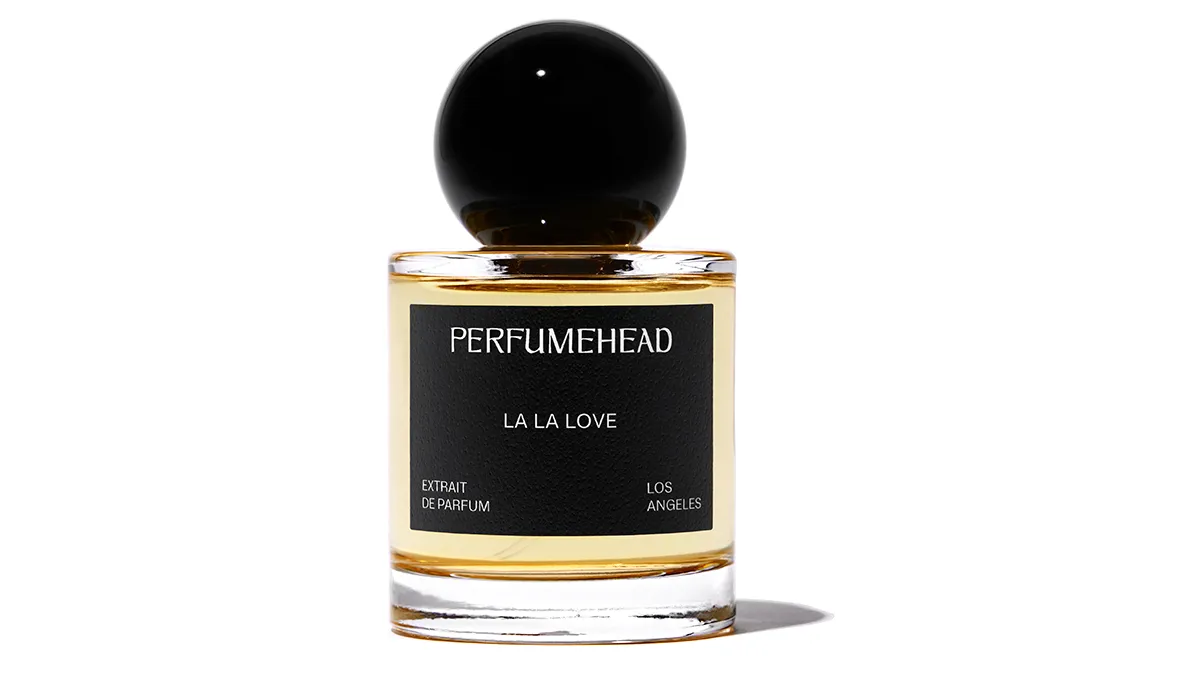
Consider this an olfactory ode to the City of Angels creatives who work as hard as they play. Perfumer Constance Georges-Picot’s gourmand concoction smells like a cocktail you could easily have one
too many of, with boozy Cognac notes mixing it up with vanilla absolute, incense, sandalwood and musk. Around $645 for 50 ml
Memo Paris Cappadocia
Cappadocia, Turkey
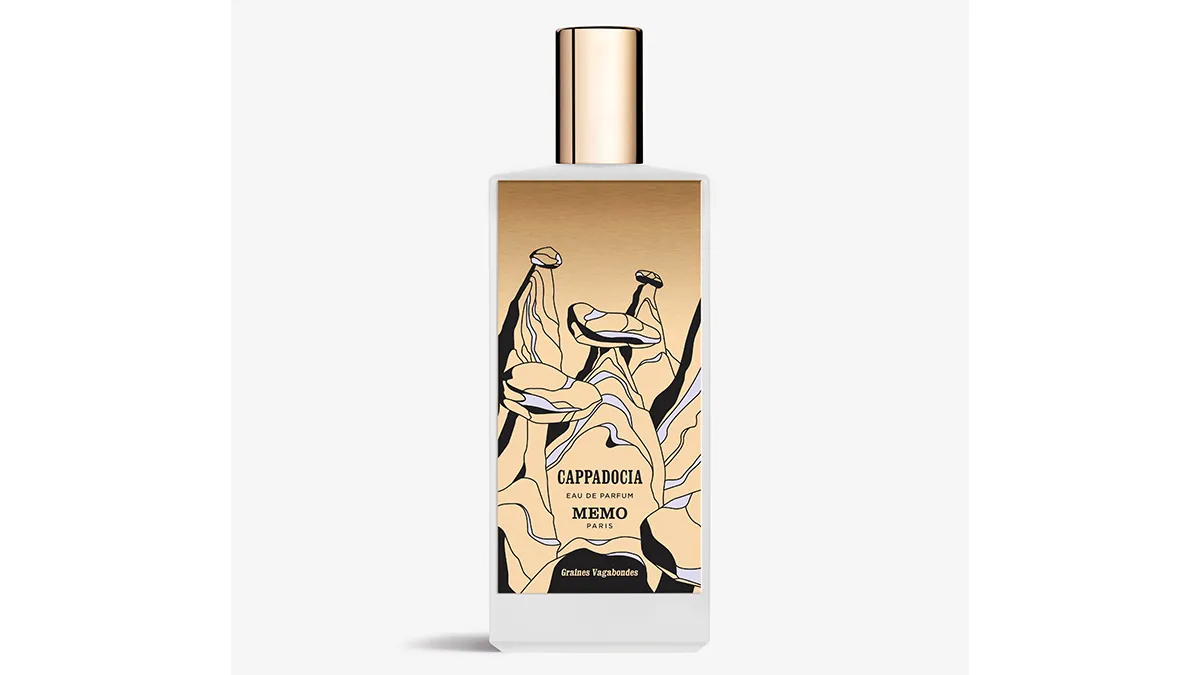
Turkey is among the world’s foremost saffron producers, and the spice’s earthy, tea-like scent takes centre stage in this effort by nose Gaël Montero. He balanced it with sandalwood, benzoin, myrrh and jasmine to create a warming scent that’s perfect for the cooler months but still works all year. $460 for 75 ml
Krigler Lindauer Löwe 08
Lindau, Germany
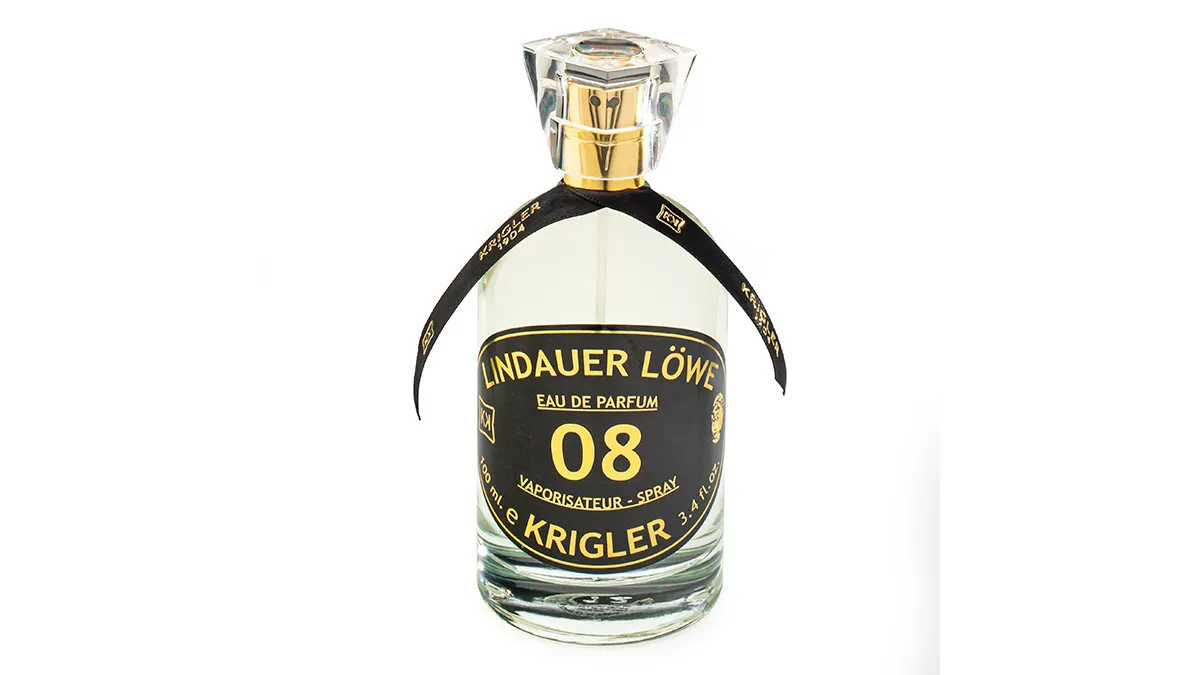
Bavaria’s answer to Capri, Lindau is a colourful island-resort town on the eastern edge of Lake Constance. Perfumer Albert Krigler loved it here so much that he dedicated a scent to the destination in 1908. His great-grandson Ben recently re-released the juice—a combination of green tea, geranium, amber and cedarwood—just this June. Around $960 for 100 ml
ILLUSTRATIONS BY Peter Oumanski
You may also like.
First Among Equals
Women are an emerging force in the watch-buying market, but their influence hasn’t been reflected at executive level—until now. The She-suite are coming.
In an era when fierce online conflicts against total strangers are normalised, where the posting of a cat meme on Instagram can spark World War III, it should come as no surprise that the modern horological battleground is equally heated—especially the moment conversations around gender enter the fray. Should women wear men’s watches? Why are brands bothering to make unisex timepieces? What’s the correct wrist-to-watch ration on a lady? Do women even like watches? At any given time, all these questions and more are bandied around social media and internet forums of varying degrees of sageness. Australian women may have secured suffrage over 100 years ago, but their right to adorn their wrists with anything they see fit is clearly not sacrosanct.
What’s not up for debate, however, is that an increasing number of women continue to enter the global space as enthusiasts, collectors and buyers, undeterred by the surrounding noise. Global market research firm Allied Market Research estimates that by 2027, the women’s watch segment will be worth around $39.6 billion. And according to the watch platform Chrono24, the proportion of women who bought luxury watches of at least 40 mm in diameter—around the starting size point for a typical men’s timepiece—grew from 21 percent to 35 percent between 2019 and 2023.
Granted, numbers of this magnitude have piqued the interest of most major brands. But behind the gleaming boutique facades and slick advertising campaigns there remains a dearth of women in senior leadership positions. CPIH, a group that represents the interests of the Swiss watch industry, reports that only 17 percent of the top horology jobs are held by women.
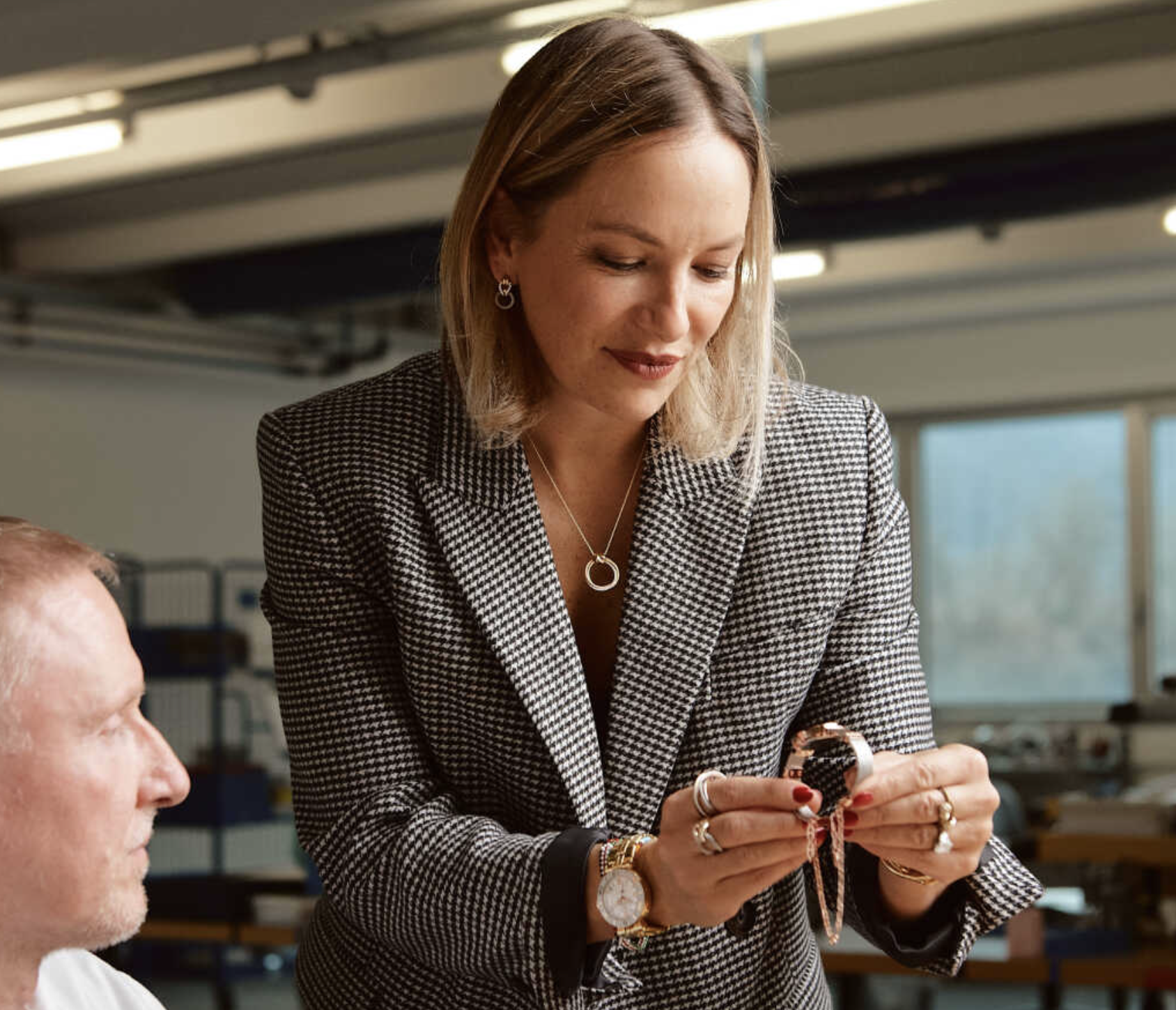
“At the top of the pyramid, in the C-suite, we’re very few,” confirms Coralie Charriol, chairman and CEO of Charriol, the Geneva-based watch company started by her father Philippe Charriol in 1983. “There’s long been women in the manufacturing, marketing and sales sides. They’re just not at the top.”
“Being the boss is freakin’ hard” she continues. “You’re the decision maker. And I’ve made the decision to model my watches off of myself in the sense that I am trying to design for an active woman, a woman who has multiple roles in her life… of course there are many, many different kinds of women. You can’t design for everyone, but you hope that what you’re creating and your message is going to reach many people as possible.”
It’s no secret that throughout watchmaking history, male executives made and marketed timepieces that largely mirrored themselves in taste, and perhaps, appearance. But, as the watch segment enters a period of unprecedented growth—a report this year by Business Research Insights puts the industry’s market size at just over $200 billion by 2031—there are green shoots of hope that a more progressive outlook will spread across executive leadership, brand partnerships and marketing efforts.

Take this year’s Watches & Wonders exhibition in Geneva, where one of the most talked-about novelties was Vacheron Constantin’s Égérie Pleats of Time concept watch. A collaboration with Yiqing Yin, a Paris-based female haute couturier and brand ambassador, the timepiece included a perfume-infused strap woven with mother-of-pearl shards. Alexandra Vogler, CMO of Vacheron Constantin, previously worked in the fragrance industry. “Merging culture and art and high watchmaking, this is very interesting,” she told Robb Report at the Swiss conference. “For me, these emotional dots I connected, I did so across three teams because I know when mixing creatives that’s how you get to birth new ideas.”
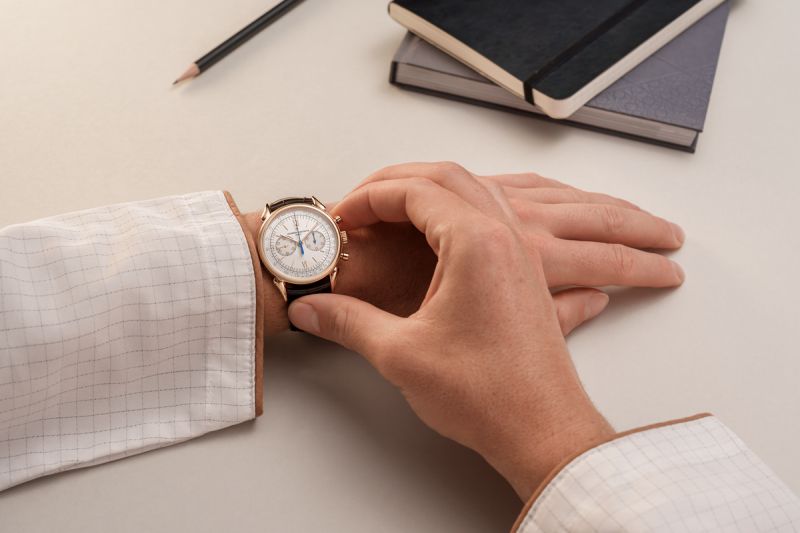
In Vogler’s roughly two years as CMO, she’s rebuilt the brand’s portfolio and announced a collaboration with the Metropolitan Museum of Art. The three-year agreement will support various educational initiatives and bespoke collaborations, including the creation of Vacheron Constantin timepieces inspired by artworks from The Met collection.
A few booths away stood Jaeger-LeCoultre’s CEO Catherine Rénier, who’d recently commissioned two-Michelin-star chef Himanshu Saini to create the Precision Atelier, a gastronomic experience that delves into the science of ingredients. Rénier, who since our chat has been tapped to be Van Cleef and Arpels’ new boss, remarked: “Watchmaking is a very niche, initiated world. So we open up this world to a larger audience through another field that will showcase similar values. And then of course, the artistic dimension is important because we do feel that more and more that the relationship to your timepiece is the same as a piece of art.”
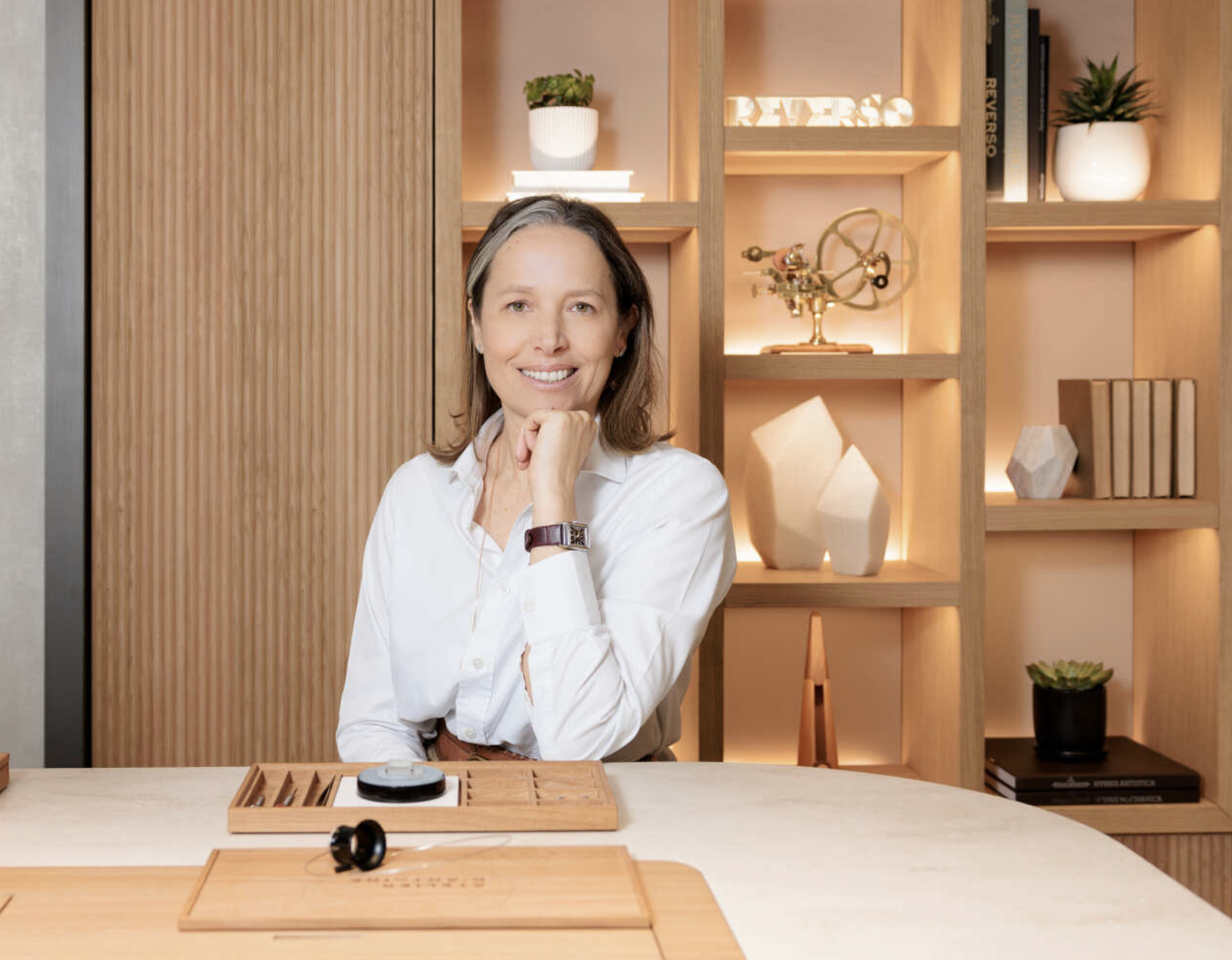
By incorporating voices from the spheres of fashion, culinary and fragrance—different domains, sure, but with shared values like precision, beauty and expertise—more varied connections to watch brands are formed beyond customers strictly interested in horology, who historically have skewed male. “I believe that you cannot talk to women the same way you talk to men about watches,” insists Coralie Charriol. “They respond to different touchpoints.”
This formula has already begun producing dividends. In February, the six variations of the Chronomat collection from Victoria Beckham for Breitling debuted, complementing the British designer’s spring/summer 2024 collection. A month earlier at Paris Fashion Week, couturier Tamara Ralph dressed her models in a limited-edition Audemars Piguet Royal Oak Concept Flying Tourbillon. Quite a way for Ilaria Resta, the marque’s incoming CEO, to make a statement. (It’s worth noting, too, that Resta joins Ginny Wright, CEO of Audemars Piguet Americas, in the C-suite of the Swiss company)
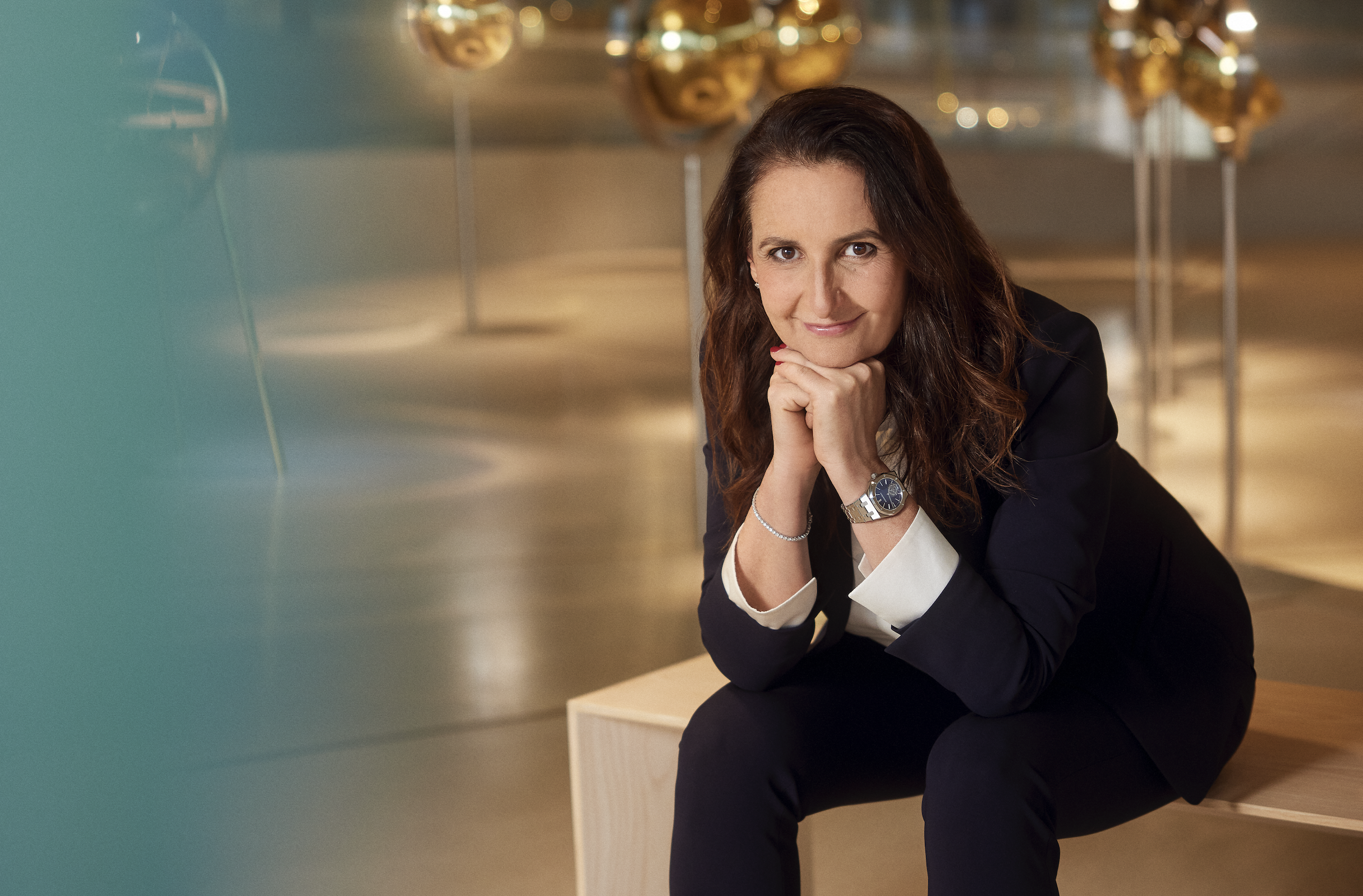
While fashion and fragrance are proving to be useful conduits for attracting more diverse audiences, female collectors are also expressing interest in more intricate timepieces.
“We have the opportunity to be in touch with more and more women and we are listening to what they want,” Resta told online magazine Revolution Watch in March (though, for the record, she declined an interview with Robb Reportfor this story). “There is a demand for complicated watches for women. The complications for women don’t necessarily have to be the same as those for men. I’ll give you an example. The Starwheel is an amazing watch that is very much loved by women. But at the moment, it only comes in a 41 mm diameter case. It is very appealing to women as a poetic representation of time and as a design statement, so of course we need to look into this.”
Female collectors throughout history, according to Vacheron Constantin’s Alexandra Vogler, have been rich veins of inspiration; in the 19th century, 30 percent of the letters received by the manufacture came from women. “We’ve had specific requests from our female clients for a rotating bezel, winding mechanisms. We have evidence in our archives demonstrating that women’s requests pushed the boundaries of innovation.”
Indeed, the history books show that women played a pivotal role in the development of modern timekeeping; it’s believed the first wristwatch was made for England’s Queen Elizabeth I in the 16th century, while in 1810, Caroline Bonaparte, the Queen of Naples, commissioned Louis Breguet to create a piece especially for her.
Perhaps, internet trolls, women are the original watch bosses after all.
You may also like.
18/10/2024
The Art of Cartier
The Cartier Maison des Métiers d’art plays a pivotal role in preserving Cartier’s most special bodies of expertise.
Cartier is a brand synonymous with lavish city living. Yet despite its swathe of multi-storey monuments to all things brilliant, it’s a rather unassuming Maison, set amidst the rolling green fields of La Chaux-de-Fond, where the house’s most special brand of magic is woven.
Seasoned connoisseurs of fine watches and jewellery are now well familiar with the works of the Cartier Maison Métiers d’art —a special workshop set up by Cartier in late 2014 to serve as a temple of traditional craftsmanship. Home to a host of artisans, many of whom have been working for Cartier for years, it has since become the de facto birthplace for Cartier’s most limited and special creations, bridging the space between haute jewellery and high horology while providing a unique ecosystem where one can influence the other.
Now a decade into its significant life, the Cartier Maison des Métiers d’art is celebrating ten years of growth and evolution. It has transformed from a special preserve for a once-threatened generation of artisans into a place where a new set of pioneering artists and craftspeople can emerge and thrive.

As guests and visitors look on, metalworkers and enamel artists create exquisite works of art using techniques and traditions once on the verge of extinction while innovative and experimenting with their own. Precious metal workers use granulation and filigree, techniques that date back to well before the start of the common era, to create one-of-a-kind reliefs.
Elsewhere, composers, engravers, and master setters experiment across experimental and traditional realms, working with everything from the most precious gems to simple stone, wood, and straw to produce pieces that, regardless of their composition, push the brand’s boundaries of creativity and attention to detail. A typical piece by the Cartier Maison des Métiers d’art takes hundreds of hours to produce.
In a world of luxury often defined by sales figures and splashy celebrity endorsements, the artistic merits of a house like Cartier can sometimes be in danger of getting lost among the noise. However, in this revered Maison, one is reminded of the craftsmanship and creativity that sets some institutions apart from the rest.
You may also like.
18/10/2024






